-
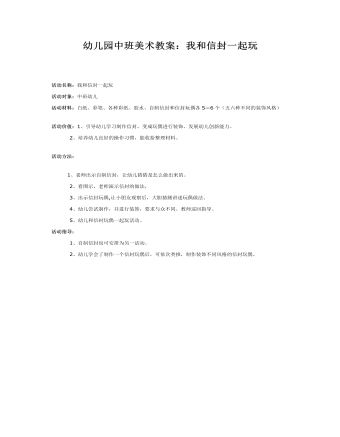
幼儿园中班美术教案:我和信封一起玩
活动对象:中班幼儿 活动材料:白纸、彩笔、各种彩纸、胶水、自制信封和信封玩偶各5—6个(五六种不同的装饰风格) 活动价值:1、引导幼儿学习制作信封,变成玩偶进行装饰。发展幼儿创新能力。 2、培养幼儿良好的操作习惯,能收拾整理材料。 活动方法: 1、老师出示自制信封,让幼儿猜猜是怎么做出来的。 2、看图示,老师演示信封的做法,
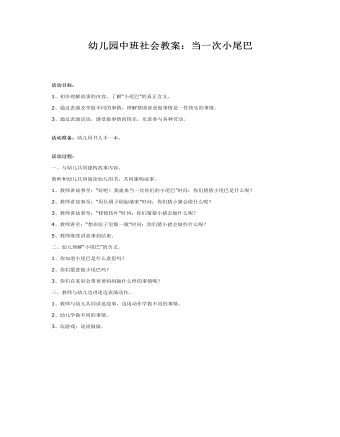
幼儿园中班社会教案:当一次小尾巴
2、通过表演及学做不同的事情,理解帮助爸爸做事情是一件快乐的事情。 3、通过表演活动,感受做事情的快乐,乐意参与各种劳动。 活动准备:幼儿用书人手一本。 活动过程: 一、与幼儿共同建构故事内容。 教师和幼儿共同阅读幼儿用书,共同建构故事。 1、教师讲故事至:“好吧!我就来当一次你们的小尾巴”时问:你们猜猜小尾巴是什么呢? 2、教师讲故事至:“用长刷子刷起墙来”时问:你们猜小猪会做什么呢? 3、教师讲故事至:“修修枝叶”时问:你们猜猜小猪会做什么呢? 4、教师讲至:“想在院子里歇一歇”时问:你们猜小猪会做些什么呢? 5、教师继续讲故事到结束。
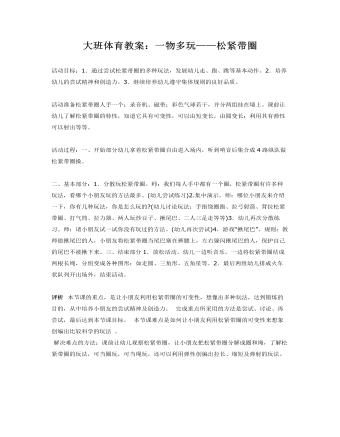
大班体育教案:一物多玩——松紧带圈
3.继续培养幼儿遵守集体规则的良好品质。活动准备松紧带圈人手一个;录音机、磁带;彩色气球若干,并分两组挂在墙上。课前让幼儿了解松紧带圈的特性,知道它具有可变性,可以由短变长,由圆变长;利用其有弹性可以射出等等。活动过程:一、开始部分幼儿拿着松紧带圈自由进入场内,听到哨音后集合成4路纵队做松紧带圈操。
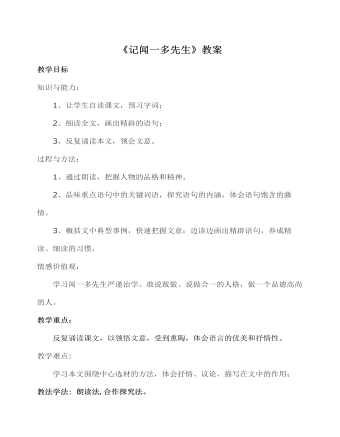
部编版语文七年级下册《记闻一多先生》教案
3、文章怎样写“作为争取民主的战士”的闻一多先生的“说”与“做”的? 文章先写他的“说”,写他“说”的事实,由“小声说”到“向全国人民呼喊”,写他“说”的内容与目的反对独裁,争取民主。再叙他的“做”:起稿政治传单,在群众大会上大骂特务,走在游行示威队伍的前头,昂首挺胸,长须飘飘。用他的“说”和“做”揭示其争取民主、反对独裁的大无畏精神。 4、细读全文,画出精辟的语句,然后复述课文大意,并说出闻一多前期和后期思想品格上的主要特点,前后期有什么变化,又有什么共同的地方。闻先生前期为了探索其救国救民的出路而潜心学术,不畏艰辛,废寝忘食,十数年如一日,终于在学术上取得累累硕果。后期则投身于民主运动,敢于为人民讲话,面对凶残的敌人无所畏惧,视死如归,体现出民主战士的大勇,成为中国革命知识分子的楷模。闻先生在前期和后期所走的道路不同,反映了他对社会认识的变化。但作为一名卓越的学者,一名伟大的爱国者,一名言行一致的志士仁人,他却是始终如一的。
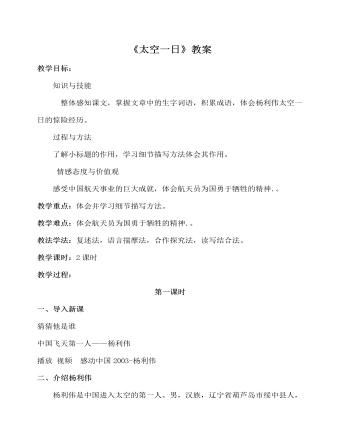
部编版语文七年级下册《太空一日》教案
五、研读课文第一部分 我以为自己要牺牲了 1在这一部分中出现了什么意外?“在火箭上升到三四十公里的高度时,火箭和飞船开始急剧抖动,产生了共振。这让我感到非常痛苦。 ”“共振以曲线形式变化着,痛苦的感觉越来越强烈,五脏六腑似乎都要碎了。我几乎难以承受,觉得自己快不行了。” 2、这种共振是正常现象吗?这种现象后来 解决了吗?并非正常现象。 “飞船的共振主要来自火箭的振动。随后他们改进技术工艺,解决了这个问题。在“神舟六号”飞行时,情况有了很大改善;在后来的航天飞行中再没有出现过。 ”3、这一部分中表现了杨利伟什么精神?为祖国航天事业勇于牺牲的精神。第二部分 我看到了什么1、杨利伟在太空看到了什么?1、地球只是一段弧 2、准确判断各大洲和各个国家的方位 3、中国上空仔细辨别大概到哪个省了,正从哪个地区的上空 飞过,祖国的各个省份我大都看到了。
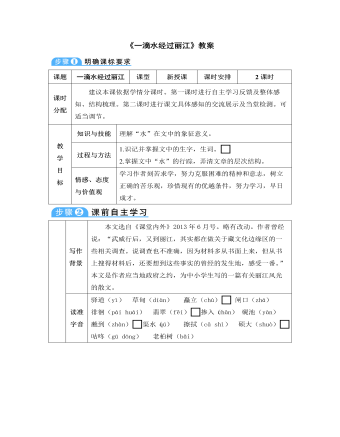
部编版语文八年级下册《一滴水经过丽江》教案
【感悟精彩句子】1. “今天,一架大水车来把我们扬到高处,游览古城的人要把这水车和清凉的水作一个美丽的背景摄影留念。”写到大水车的用意是什么? 大水车是丽江古城的标志性建筑,成为了丽江古城的地标,也是游客们一定要去拍照留念的地方。历史足迹明显,地域特色突出。2. 一些薄云掠过月亮时,就像丽江古城中,一个银匠,正在擦拭一只硕大的银盘。联想,古城的民俗难以忘怀。3.“我知道,作为一滴水,我终于以水的方式走过了丽江。”这样的结尾,体现了一滴水怎样的情怀?〖ZK)〗欣赏了风景如画的丽江,考察了“土”味浓郁的建筑,体会了丰富多彩的民俗民风,美感袭身,皆满足矣。融入更加广阔的江海,开始一滴水热情、奔放的新生活。
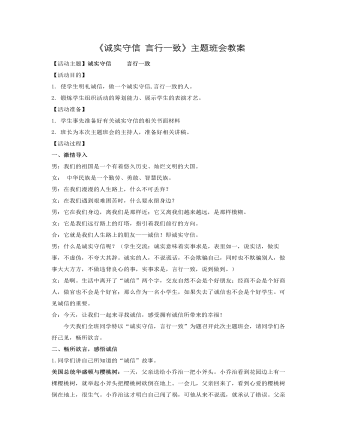
《诚实守信 言行一致》主题班会教案
【活动目的】1. 使学生明礼诚信,做一个诚实守信,言行一致的人。2. 锻炼学生组织活动的筹划能力、展示学生的表演才艺。【活动准备】1. 学生事先准备好有关诚实守信的相关书面材料2. 班长为本次主题班会的主持人,准备好相关讲稿。【活动过程】一、激情导入男:我们的祖国是一个有着悠久历史、灿烂文明的大国。女: 中华民族是一个勤劳、勇敢、智慧民族。男:在我们漫漫的人生路上,什么不可丢弃?女:在我们遇到艰难困苦时,什么要永留身边?男:它在我们身边,离我们是那样近;它又离我们越来越远,是那样模糊。女:它是我们远行路上的灯塔,指引着我们前行的方向。合:它就是我们人生路上的朋友——诚信!即诚实守信。男:什么是诚实守信呢?(学生交流:诚实意味着实事求是,表里如一,说实话,做实事,不虚伪,不夸大其辞。诚实的人,不说谎话,不会欺骗自己,同时也不欺骗别人,做事大大方方,不做违背良心的事,实事求是,言行一致,说到做到。)
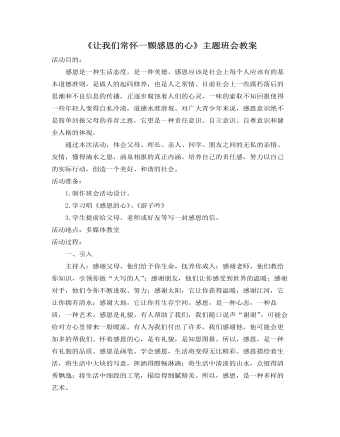
《让我们常怀一颗感恩的心》主题班会教案
一、引入 主持人:感谢父母,他们给予你生命,抚养你成人;感谢老师,他们教给你知识,引领你做“大写的人”;感谢朋友,他们让你感受到世界的温暖;感谢对手,他们令你不断进取、努力;感谢太阳,它让你获得温暖;感谢江河,它让你拥有清水;感谢大地,它让你有生存空间。感恩,是一种心态,一种品质,一种艺术。感恩是礼貌。有人帮助了我们,我们随口说声“谢谢”,可能会给对方心里带来一股暖流。有人为我们付出了许多,我们感谢他,他可能会更加多的帮我们。怀着感恩的心,是有礼貌,是知恩图报。所以,感恩,是一种有礼貌的品质。感恩是画笔。学会感恩,生活将变得无比精彩。感恩描绘着生活,将生活中大块的写意,挥洒得酣畅淋漓;将生活中清淡的山水,点缀得清秀飘逸;将生活中细致的工笔,描绘得细腻精美。所以,感恩,是一种多样的艺术。下面我宣布“让我们都有一颗感恩的心”主题班会现在开始!
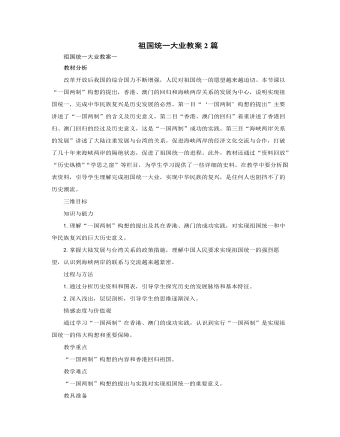
人教版高中历史必修1祖国统一大业教案2篇
教材分析改革开放后我国的综合国力不断增强,人民对祖国统一的愿望越来越迫切。本节课以“一国两制”构想的提出,香港、澳门的回归和海峡两岸关系的发展为中心,说明实现祖国统一,完成中华民族复兴是历史发展的必然。第一目“‘一国两制’构想的提出”主要讲述了“一国两制”的含义及历史意义。第二目“香港、澳门的回归”着重讲述了香港回归、澳门回归的经过及历史意义,这是“一国两制”成功的实践。第三目“海峡两岸关系的发展”讲述了大陆注重发展与台湾的关系,促进海峡两岸的经济文化交流与合作,打破了几十年来海峡两岸的隔绝状态,促进了祖国统一的进程。此外,教材还通过“资料回放”“历史纵横”“学思之窗”等栏目,为学生学习提供了一些详细的史料。在教学中要分析图表资料,引导学生理解完成祖国统一大业,实现中华民族的复兴,是任何人也阻挡不了的历史潮流。
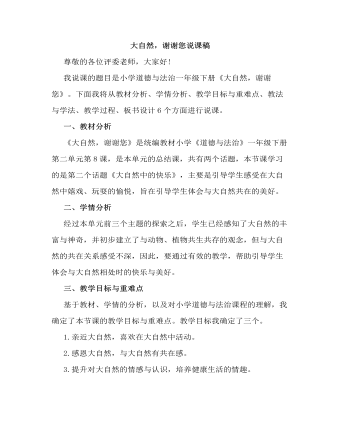
人教部编版道德与法制一年级下册大自然谢谢你
接着,教师引导学生与大自然对话,说一说:“大自然,我想对你说……”。设计意图:提升学生对大自然的情感与认识,感恩自然,喜欢在大自然中活动。活动三:阅读绘本,感恩自然学生阅读教材第30页到33页的绘本《大自然的语言》,教师引导学生说一说,大自然不仅给我们物质的馈赠、精神的馈赠,还给我们带来智慧的启迪。(板书:感恩)设计意图:再次感受与大自然的共在的情感。环节三:课堂小结,内化提升学生谈一谈学习本节课的收获,教师相机引导。设计意图:梳理总结,体验收获与成功的喜悦,内化提升学生的认识与情感。环节四:回归生活,拓展延伸课后,请同学们走进自然,拥抱自然。设计意图:将课堂所学延伸到学生的日常生活中,有利于落实行为实践。

新人教版高中英语必修2Unit 1 Cultural Heritage-Discovering Useful Structure教案一
This teaching period mainly deals with grammar “restrictive relative clauses.” To begin with, teachers should lead students to revise what they have learned about the relative pronouns and relative adverbs. And then, teachers move on to stress more special cases concerning this grammar, such as the “preposition+ relative pronouns which and whom” and cases where we can omit the relative pronouns. This period carries considerable significance to the cultivation of students’ writing competence and lays a solid foundation for the basic appreciation of language beauty. The teacher is expected to enable students to master this period thoroughly and consolidate the knowledge by doing some exercises. 1. Guide students to review the basic usages of relative pronouns and adverbs of attributive clauses.2. Lead students to learn to use some special cases concerning restrictive relative clauses flexibly.2. Enable students to use the basic phrases structures flexibly.3. Strengthen students’ great interest in grammar learning.1. Help students to appreciate the function of relative pronouns and adverbs of attributive clauses in a sentence2. Instruct students to write essays using the proper relative pronouns and adverbs of attributive clauses.本节语法思考:定语从句在复合句中的作用是什么? 关系词有哪些?定语从句在复合句中的作用相当于形容词,它在句中作定语修饰名词或代词。他们在先行词和定语从句之间起到联系作用,同时在意义上代表先行词并在定语从句中担任一个成分。被定语从句所修饰的词称先行词,定语从句一般放在先行词的后面。

新人教版高中英语必修2Unit 1 Cultural Heritage-Reading and Thinking教案一
The theme of the reading and thinking is about “Understanding how a problem was solved”.The Listening & Speaking & Talking is about international co-work to protect the Mount Tai, in which the students from seven countries came up with many solutions even create the Mount Tai App. This section aims at showing how to solve a difficult and even tough problem about protecting the cultural heritage by the international co-work. So in this section, cultivating students’ international awareness is very clear and important. Concretely, with the economic development, how to balance the protection of cultural relics and social development is a big challenge for human. In the 1950s, the Egyptian government wanted to build the Aswan Dam across the Nile to control floods, produce electricity and water farms. But the proposal led to protests because it would destroy a lot of cultural relics. The Egyptian had no choice but ask the UN for help. Therefore, a international cooperation about how to protect the cultural relics began, which involved the time length about 20 years and a large amount of fund. Then, the problems was solved. 1. Read quickly to get the main idea and the structure of the article; read careful to get detailed information.2. Learn to use the reading strategy---making a timeline3. Learn how to solve a tough problem by asking for help and cooperation4. Have the international awareness and understand the great strength of international cooperation.1. Read quickly to get the main idea and the structure of the article; read careful to get detailed information.2. Learn to use the reading strategy---making a timeline.3. Learn how to solve a tough problem by asking for help and cooperation.

新人教版高中英语必修2Unit 2 Wildlife Protection-Discovering Useful Structure教案一
The activity topic of this section is "report an ongoing event", and the structure is the passive voice of present continuous tense. Rare wild animals are suffering from large-scale poaching, and species are on the brink of danger. Rescue operations are underway. "Being" and "suffering" are the meanings of the present progressive passive voice.The usage of present progressive passive voice is of great importance in writing a good discourse and appreciating some difficult language items, so it is vital to master it and use it flexibly in a context.1. Motivate Ss to deepen the understanding of the usage of present progressive passive voice in a fixed context.2. Enable Ss to master the usage of present progressive passive voice and use it flexibly in a context.3. Lead Ss to construct sentences or appreciate sentences used master it and use it flexibly in a context.1. Help students to appreciate the function of the usage of present progressive passive voice in a sentence2. Instruct students to write essays using the proper usage of present progressive passive voice.Look at the picture and tell me what are workers doing? What is the house being done?

新人教版高中英语必修2Unit 2 Wildlife Protection-Reading and Thinking教案一
The listening and speaking part aims at how to protect and help endangered animals by listening, speaking and talking about the facts and reasons. This lesson analyzes the decreasing clause of Tibetan antelope population and the measures of protecting Tibetan antelopes. So students can be guided to learn to analyse the title and use different reading skills or strategies, like scanning, skimming and careful reading.1. Read quickly to get the main ideas and the purpose of going to Tibetan; read carefully to understand what the author see and think.2. Understand the sentences of the present continuous passive voice such as “Much is being done to protect wildlife.” and the inverted sentence “Only when we learn to exist in harmony with nature can we stop being a threat to wildlife and to our planet.”3. Enhance the awareness of protecting wildlife.4. Cultivate the reading methods according to different materials.1. Read quickly to get the main ideas and the purpose of going to Tibetan; read carefully to understand what the author see and think.2. Understand the sentences of the present continuous passive voice such as “Much is being done to protect wildlife.” and the inverted sentence “Only when we learn to exist in harmony with nature can we stop being a threat to wildlife and to our planet.”3. Cultivate the reading methods according to different materials.Step 1 Leading-inWatch a video about elephants and whales and then ask:Why are they endangered ? They are killed/hunted

新人教版高中英语必修2Unit 2 Wildlife Protection-Reading For Writing教案一
1. 标题首先根据海报的特点、格式写明标题。海报中往往把内容作为大标题。例如: Save the earth, Save the birds。2. 正文部分不同的海报其正文部分的侧重点不同。对于介绍性的海报, 首先要引出话题, 其次列出原因, 最后是总结。对于宣传类的海报, 要写明具体内容, 如: 活动内容, 地点以及参加活动的注意事项, 主持或举办单位等。1. 图片: 要选择引人注目的图片, 与主题要相关, 色彩明亮。话题句式 1. It is a treasure of our country. 它是我国的国宝。2. Believe it or not, at present only several thousand pandas exist in the world. 信不信由你, 目前世界上仅现存几千只熊猫。 3.It’s because of human activities that tigers are endangered. 正是因为人类的活动, 老虎处于濒危的状态。4. Many wild animals are in danger of dying out. 很多野生动物面临着灭绝的危险。 5. The government has taken effective measures to protect them. 政府已采取有效的措施来保护它们。6. People should raise the awareness of the protection of wild animals. 人们应该提高保护野生动物的意识。 7. It’s amazing that there are merely less than 1, 000 finless porpoises living in China. 非常令人吃惊, 目前中国仅有不足1 000只江豚。

新人教版高中英语必修2Unit 3 The Internet-Discovering Useful Structure教案一
This unit is about the Internet, which has a great influence to our humans and our lives. During the Listening & Speaking & Talking and Reading and Thinking section, the influence in examples has been shown. Thus, use the Present Perfect Tense is appropriate. However, in order to show the justice or weaken the doer of the behavior/action, it’s better to use the Present Perfect Passive Voice than the Present Perfect Tense. Besides, having learned to use the Present Perfect Passive Voice, students can beautify their language in their writing. 1. Learn the structure of the Present Perfect Passive Voice and its functions. 2. Learn to change the sentences with the Present Perfect Passive Voice into the sentences with the Present Perfect Passive Voice. 3. Learn to write sentences with the Present Perfect Passive Voice flexibly according to the context. 1. Learn the structure of the Present Perfect Passive Voice and its functions. 2. Learn to change the sentences with the Present Perfect Passive Voice into the sentences with the Present Perfect Passive Voice. 3. Learn to write sentences with the Present Perfect Passive Voice flexibly according to the context. Step 1 Observe the following sentences, then change the sentences into passive voice.He has been selected to take part in the sports meeting.(肯定句)他已被挑选出来参加运动会。The ink has not been removed from his overcoat.(否定句)墨迹还没有从他外套上去掉。

新人教版高中英语必修2Unit 3 The Internet-Listening &Speaking&Talking教案一
Listening and Speaking introduces the topic of “ask about online habits”. Many middle school students have been surfing the Internet for many years, but what they do with the Internet and how much time they spend every day may not be very clear to themselves, nor to other students. This section allows students to investigate their peers' Internet use, which is conducive to their mutual understanding and understanding of the Internet. It can also help them reflect on their own online behavior, learn from other people's good online habits, and get rid of their bad online behavior.The listening text of this section is an investigation interview. The investigators interview specific groups with the same questions to obtain information, so as to understand their views, practices or attitudes on this issue. There are two specific questions: “how much time do you spend online every day? What do you usually do online?”. The answers of the three respondents provide rich and different information, and achieve the purpose of the investigators. The oral discourse structure of survey interviews generally includes greeting and explaining the purpose of the interview, presenting the interview questions and the respondents' answers. Listening and Talking introduces the theme of “choosing the right application ". Listening text is a conversation between Laura and Xiao Bo. In this part of listening, “oink”; “piggy bank” may cause the students' hearing comprehension limitation. Oink refers to sound word and pig's sound. So, add some oink to my piggy bank is often used to describe "making a little money".1. Guide students to understand the content of listening texts in terms of listening for definitions.2. Cultivate students' ability to define words and understand an investigation interview.

新人教版高中英语必修2Unit 4 History and Traditions-Discovering Useful Structure教案一
Step 5 Practice一、完成下列句子。1. Judy and I _______________(把车停下来(park))in an underground car Park near Trafalgar Square, where we could ______________________(让我们的车充电(charge)).2. When we finally reached the service desk to ask for audio guides, we heard it ___________ that there were no audio guides____________(留下,剩下).3. We__________________________(发现自己对...很惊讶)the large number of visitors and the amount of noise at the entrance of the National Gallery.4. Judy ____________________(眼神专注于) Van Gogh’s Sunflowers. It was hard to approach the painting as there were so many people around.5. She ____________________(把这幅画的复制品装箱(box)) to ensure that it was delivered safely.答案:1.had our car parked get our car battery charged 2. announced left 3. found ourselves very surprised 4. had her eyes fixed on 5. had a copy of the painting boxed二、用过去分词对下列句子进行改写。1. Loch Ness was surrounded by beautiful natural landscape, which made it look amazing.2. Carl and his friend stayed with a generous family who offered them bread with butter and honey that was homemade.3. The family’s ancestors once attended to soldiers who were wounded in the First World War.4. The young people were attracted by the legend of Loch Ness. They watched over the lake with their cameras and binoculars, which were positioned on the hill.答案:1. Loch Ness surrounded by beautiful natural landscape looks amazing.2. Carl and his friends stayed with a generous family who offered them homemade bread with butter and honey.3. The family’s ancestors once attended to wounded soldiers in the First World War.4. The young people attracted by the legend of Loch Ness watched over the lake with their cameras and binoculars positioned on the hill.

新人教版高中英语必修2Unit 3 The Internet-Reading and Thinking教案一
Paragraph 3. Jan decided to start an IT club to teach old people how to use computers and the Internet. Paragraph 4. Jan has started taking online classes to learn more about how to use the Internet to make society better. Paragraph 5. Jan’s life has been greatly improved by the Internet. Step 5: Critical thinking:(1)How do you arrange your time spent on study and the Internet? Is it reasonable? I usually surf the Internet using my mobile phone for only an hour after class, and it is reasonable for me.(2)What are your online activities? Are they safe? I chat with my friends, read news and play games. I never give away my private information so I think they are safe.Step 4: summary Much has been written about the wonders of the World Wide Web. There are countless articles (1)______(tell) us how the Internet has made our lives more convenient. But the Internet has done a lot (2)_____(much) for people than simply make life more convenient. People’s lives (3) _________________(change) by online communities and social networks so far. Take Jan for example, who developed a serious illness that made her (4)_____(stick) at home with only her computer to keep (5)___(she) company. She joined an online group (6)______ she could share problems, support and advice with others. She considered the ability to remove the distance between people as one of the greatest (7)_______(benefit). She was so inspired (8)____ she started an IT club in which many people have been helped. She has started to learn more about how to use the Internet to make society better. Her next goal is to start a charity website to raise money (9)___ children in poor countries. Jan’s life has been (10)______(great) improved by the Internet. Step 5 Homework:Review what we have learned and find out the key language points in the text.

新人教版高中英语必修2Unit 4 History and Traditions-Listening&Speaking&Talking教案一
This unit is about history and traditions. From the opening page, we can know that this unit will introduce the history and traditions around the world. As Marcus Garvey says “A people without the knowledge of their past history, origin and culture is like a tree without roots”, it is important for students to realize the importance and value of knowing the history and traditions and their further meanings. And this part ( listening and speaking ) is divided into two parts: Part A---share views on historic sites, Part B ---talk about a visit to a historic tourist destination. By talking with a foreigner, the speakers introduce the historic attractions and their cultures. Part A is that William, a British student, who was going to visit the Confucius Temple and a Chinese student, Xiao Kong, who was going to the Confucius Temple to meet with the members of the research group, went together and exchanged their views on the Confucius Temple, Confucius, Confucius' descendants and Confucius' educational thoughts. Part B is a conversation between Xiao Yan, a youth hostel receptionist and Paul, a backpacker about the feelings and experience after visiting the Chinese famous tourist attraction Pingyao.1. Guide students to understand the content of listening texts in terms of the whole and key details; 2. Cultivate students' ability to guess the meaning of words in listening; discuss with their peers how to talk about historic spots and great person.3. Instruct students to use functional sentences of showing one’s excitement, surprise and disappointment.1. Guide students to understand the content of listening texts in terms of the whole and key details; 2. Cultivate students' ability to discuss with their peers the related topics.3. Enable students to use the functional items of showing one’s excitement, surprise and disappointment.